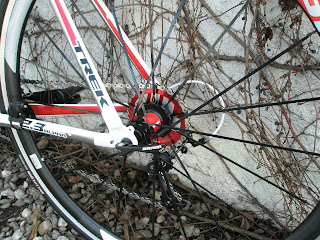So, just who am I, and how did I come to riding, and ultimately, editing a
cycling blog? I could go back all the
way to the day I learned to ride a Schwinn Sting Ray as a boy, or the day I got
my first ten-speed from Toys ‘R Us, or my first real road bike in 1985 (a
Nishiki Sport), but I will start with the purchase of a Trek 4500 mountain bike
in 1996.
It was the 4500 that got me kinda’ bitten with the road-bug
after I put slicks on it in 2009. Prior
to that, it made a few trail rides, a lot of street rides, and spent even more
time as a clothes hanger. Then, I got
serious about my fitness.
1996 Trek 4500
I rode the 4500 until I was maxing out the gears and thought
I needed a new, proper road bike. I sold
the 4500 in 2010 and went looking for a new ride. I had no exact idea of what I wanted, or even
what I needed, however, being that Trek was the only product I knew and
understood at the time, I looked for an aluminum framed road bike. Carbon was still a complete mystery to me.
So, I began researching Trek bikes on the net and saw some I
believed would fit the bill. It was
during this time I discovered what should be, if it already is not, one of
cycling’s prime axioms – Buy the best
equipment you can almost afford. So,
while looking at the 1.1, 1.5, and 2.1, I decided on the 2.3, Trek’s top of the
line alloy road bike (in the USA). The 2010 Trek 2.3 came stock with a complete
Shimano 105 build, Bontrager branded Race wheels, a carbon fork and a carbon
seatpost. It also came with house
branded tape, R1 saddle, and an alloy bar and stem. I rode it in this exact configuration only
once.
2010 Trek 2.3
My initial forays on the 2.3 were a little odd, and the
learning curve was thankfully short. The
first thing to master was the clip-less Look pedals (the 4500 had clips). The second were the STI shifters (Shimano
Total Integration). I was only used to
downtube units, so this whole brake lever-gear shifter thing was completely new
(I have also since discovered 105’s durability is matched by its inability to
stay in tune for any length of time). Fortunately, I leaned it quickly, as well. Still, the whole clip-in, clip-out thing took
some getting used to, especially the clip-out part. To date, I have only fallen over by failing
to clip-out on two occasions.
So, just how did the
metamorphosis into Frankenbike begin?
Personalization, comfort and performance are the name of the
game in cycling (in my case, I can also add fate to that mix). The first thing
to go was the Bontrager R1 saddle, which was swapped for a WTB Silverado
unit. The next thing to go were the
wheels. A member of the riding club I
had joined (a good thing to do, especially if you are a new rider) had a spare
set of Mavic Ksyrium SL’s, regulating the Bontrager’s to indoor trainer duty. After that came a major upgrade. To better cope with the hills in my area, I
swapped the stock Shimano 12-27 cassette for a SRAM PG-1050 11-32 and a Shimano
105 GS, long-cage rear derailleur. Then
came a Ritchey WCS 4-Axis alloy 120mm stem, WCS Logic II alloy bar (with
Ritchey tape), a WCS alloy seatpost, and a WCS Carbon Streem saddle. Then came an Ultegra crankset and bottom
bracket (not by choice – See below), and finally a SRAM Red OG-1090, 11-28
cassette, Red/Black brakeset, and S40 wheels.
Oh yeah, somewhere in there a Garmin Edge 500 found its was onto the
bike, as well, replacing the original Bontrager Trip 1 computer.
The WTB saddle worked out OK, but it was a bit too dished
for me, so that got sold to a Fat-Tire friend of mine. As for the crankset, well, after a
mis-adjustment by a careless mechanic destroyed the big rings, that shop
stepped up and replaced it with an Ultegra crankset and bottom bracket. The increased stiffness was immediately
noticeable.
The Bontrager Race wheels, while having a pseudo-aero profile and
bladed spokes, weighed a ton. Well, to
me they did. My 2005–ish Mavic Ksyrium's
come in at 1540 grams, and the Race’s were a portly 1929 grams. The SRAM S40’s I am currently evaluating/using
run 1740 grams, however, their 38mm depth, and surprisingly compliant ride, has
me using them as my daily wheel for all occasions.
I must also mention during this period I have become very
good friends with a supplier of mine,
Tweaked Sports of Glendora, California,
and they have not only provided top-notch customer service, but they have also
provided me a with quite a lot of products to test.
"Frankenbike" as of September 2012
So, (thanks to Tweaked Sports) my 2.3 has now become a
rolling test-bed as well as my daily rider.
As it currently stands, it is rigged with the aforementioned SRAM S40’s,
Titanium skewers, Red/Black brakes, and Red OG-1090 11-28 cassette, Ritchey WCS Logic II bars,
WCS seat post, WCS Carbon Streem saddle, WCS C260 unidirectional (UD) 120mm
carbon stem, Shimano Ultegra crankset and bottom bracket, 105 shifters, front
derailleur, long-cage rear derailleur, Blackburn carbon cages and Michelin Pro
3 Race tires
So there we have it.
What began as a simple jump back into road cycling after 25 years has
now become my rolling-reliable test bed for new products. However, I love it, I will keep it, and I will continue to
use it even after my first carbon bike arrives. It is now what one rider at an on-line forum once wrote, “No
longer a 2.3.”
Maybe, it isn’t. But,
it still flexes like one.
Now, if I could only settle on one complete gruppo.
















